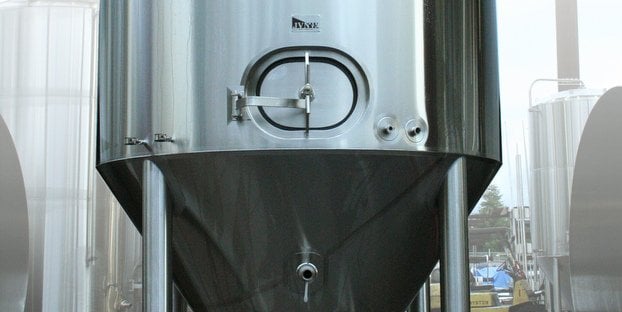
The craft of brewing beer is perfected and mass produced in a variety of specialized commercial vessels. From mills and mash mixers to can- and keg-filling equipment, there is a veritable warehouse full of machinery in the brewing process — if it’s to be efficient, trouble-free and profitable. This week, we’ll single out fermentation vessels, which transform wort into beer.
First off, your local brewing vessel manufacturer or supplier is a great place to start your journey for a new fermenter. These folks are the experts, and they offer complete services that should include a variety of product options, attentive sales experts, complete design capabilities and installation crews. They basically do all the work for you. Ken Ovnicek, sales manager for beverage and industrial products for Spokane Industries, is a great example.
“Spokane Industries offers brewery conical bottom fermenters, bright beer tanks and hot and cold liquor tanks — from 20 bbl [24 hectoliters] up to 400 bbl [479 hl],” Ovnicek said, explaining the product line of the Spokane, Wash.-based vessel manufacturer. “We also offer floor layout services to help the end-users determine tank layout with the best efficiency of floor space. We offer installation services as well.”
There are many varieties of brewing vessels in a complete brewery system, but for the sake of space we’ll only be focusing on fermenters today (extracted from that long, connecting chain of vessels that brew craft beer). It’s an especially important ticket item for expansion because you can’t brew a lot of beer without a lot of fermenters. You could buy one, or you could buy 21. Victory Brewing Co. (Downingtown, Pa.) just announced the arrival of 16 new 200-barrel (bbl) fermentation tanks. SweetWater (Atlanta) is putting the finishing touches on its $19 million expansion, and it’s touting 10 new 1,000-bbl fermenting tanks. They come in all sizes, big and small (from 20 to 6,000 bbl), and they come with a variety of choices.
When it comes to creating the beloved alcohol that is in our craft beer, fermentation vessels are used to convert sugars (derived mostly from the malt) into ethanol or alcohol. Yeast is introduced during the fermentation process, and it’s used to convert the glucose (sugars) from the wort (that sweet liquid that comes from mashing the grains), producing both ethanol and carbon dioxide gases (CO2). The yeast also produces a series of minor metabolites such as esters, higher alcohols and acids that contribute positively to flavor.
All of this chemistry can be conducted with precision in a brewing fermenter — if you can pick, install, operate and clean the right vessel. Besides your tank manufacturer, a good place to start looking at options is actually at other craft breweries, according to Chantal Reichwage, product specialist with G.W. Kent Inc., a vessel manufacturer based in Ypsilanti, Minn.
“Breweries that are just starting or are expanding operations really need to inspect the equipment that is in service at other breweries — to see quality difference,” Reichwage said. “Craft breweries are demanding increased convenience and efficiency technologies in their new fermenters. That means better quality manway doors, glass manways for the brewhouse and a high quality of stainless steel valves and fittings for longer service life. In this industry, you usually get what you pay for.”
Fermentation and maturation can be carried out in a variety of tanks — open or closed, horizontal tanks with manholes or vertical tanks with conical bottoms. We’ve even seen old, converted dairy tanks used for fermentation by clever, budget-conscious brewers. But when it comes to commercial craft brewing products today, fermenters are usually cylindroconical.
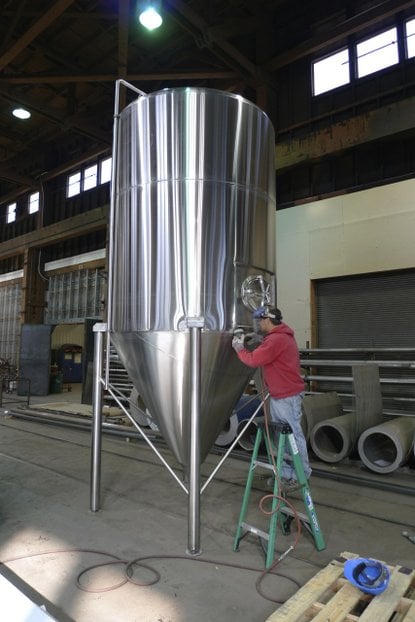
The original, old world commercial fermenters were open-air square tanks, but today the cylindroconical vessel is the industry staple for the American craft brewing industry. Engineered with a conical bottom and a cylindrical top, these vessels are usually three to four times taller than their diameter, fabricated from stainless steel, engineered with adjustable foot supports and racking. Beer nerds can thank Leopold Nathan, who patented the cylindroconical fermenter in 1927, claiming faster fermentation rates. Financially, cylindroconical vessels offer a bevy of pluses — lower capital costs, lower operating costs and minimized space requirements.
Also, the science says cylindroconical fermenters have many advantages — better mixing due to convection currents set up by rising gas bubbles, ease of temperature control, ease of cleaning and easy and hygienic recovery of yeast from the base (or cone). The cone’s aperture is typically around 70 degrees, an angle that will allow the yeast to flow toward the cone’s apex. We should note that there are some systems that combine fermentation and conditioning in the same vessel.
“That’s called a unitank, which is a fermentation tank that has both primary and secondary fermenting and aging functions in one tank,” explained Brandon LeBlanc, project engineer for JVNW Inc., a vessels and turn-key systems engineering company from Canby, Ore. “But most folks use a bright beer tank or conditioning tank for aging, conditioning and carbonation.”
Different types of fermentation and yeast will be used depending on what is being brewed in the fermenting vessel (lagers or ales). A quick recap: Ales are made with top-fermenting strains of yeast, which means that the yeast ferments at the top of the fermentation tank. Lagers use bottom-fermenting yeasts, which sink to the bottom of the tank and ferment there.
“Like most vessel experts, JVNW makes fermentation tanks that can handle both styles of beer, customized to specific needs,” LeBlanc said.
Big differences can be seen in the fermentation times of ale and lagers, which is reflected in the flavor of the resulting beer. It logically follows that the vessels for fermentation must be equipped to regulate these differences consistently, eliminating variances in the taste, alcohol content and visual look of the beer being brewed. Of special importance will be the fermentation control systems. How will temperature be controlled? How will yeast be added (called pitching)? How will it be extracted? How will you sample and observe the fermenting process? How will this vessel be cleaned?
“What are your current and future needs? What is your location? What are your internal tank pressure requirements? What are your room constraints?” LeBlanc asked. “We’ve helped a lot of craft breweries answer those types of questions. People like 10 Barrel Brewing Co., Port City Brewing Co., Hop Valley Brewing Co. and Caldera Brewing Co.”
First off, fermentation is an exothermic process (a reaction that releases energy), so the rising temperature of the fermentation will need to be carefully controlled. Typically, lagers will be fermented at temperatures between 42˚F and 57˚F for as little time as three to four days but as long as a few weeks. Ales have always been fermented at higher temperatures (59˚F to 68˚F). The resulting ales tend to contain more complex flavors and faster fermentations (at usually two to three days). Fermenter temperature controls for small craft breweries can be as simple as analogue gauges attached to the unit, but for larger systems they can be as complex as advanced digital control panels that run multiple vessels.
“It normally is determined by the individual brewer, but you can order the fermenter with two thermo-wells — one would be used with a dial thermometer and the other would be used for a thermal coupler probe that would connect to a control unit that could regulate the temperature with the use of control valves in the glycol chiller system,” Ovnicek said.
The excess heat being created must be removed from the fermenter if the temperature of fermentation is to be controlled, which means the fermenter must usually be equipped with a “cooling jacket” to remove heat generated during that exothermic reaction and other ambient temperature factors. For craft breweries, high-quality, low-pressure, dimpled cooling and heating jackets using glycol and water is the most popular option. These jackets are also available for cooling in high-pressure flow of freon or ammonia. These systems ensure continuous, precise control of temperature. A commercially equipped fermenter will probably have two cooling sections on the cylinder of the tank and a further section on the cone.
“Spokane Industries offers a dimpled cone bottom glycol cooling jacket instead of a channel style, giving a more even temperature control in the bottom cone,” Ovnicek said. “The dimpled cooling jackets are constructed using two pieces of stainless steel. The base metal is normally 12 or 10 gauge [.105 in. or .135 in. thick], depending on the diameter of the tank, and the jacket material is normally 18 gauge [.048 in. thick].
“The two pieces are sandwiched together and resistant spot-welded with an automated 16 gun spot-welder on an indexing table that automatically shifts the sheet of metal through the machine,” Ovnicek continued. “The sandwiched sheets are fed through the machine in the flat position with the base metal being 3-, 4- or 5-feet wide, and the length as long as needed to make the circumferential wrap for the diameter of tank desired. The jacket being less in width and length than the base sheet.”
Once the spot welding is completed, the material is then rolled to the proper diameter and the jacket to shell seam is seal-welded. Two nozzles are now welded to the jacket, allowing an inlet and outlet for a substance like glycol. The last step is to inflate the dimpled jacket through the inlet, this is completed by applying hydrostatic pressure between the base and jacket material until the proper dimple depth is accomplished. A good cooling jacket will keep its cool when compressed glycol is passing through it.
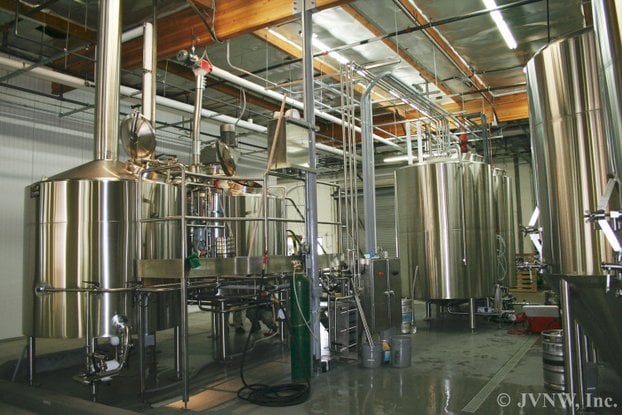
Fermenters may also require insulation to help with temperature control. Outside tanks are insulated against ambient conditions, while indoor tanks will require insulation to lessen the demands on the temperature control system.
“There are many ways to insulate,” Ovnicek said. “We are currently using two layers of Pryogel manufactured by Aspen Aerogels, giving a high insulation value in about half the space of standard foam-style insulations. We then seal-weld a 14 gauge [.075 in. thick] cladding over the top of the insulation to keep it water tight.”
Many important fermenter technologies are engineered into the best craft brewing cylindroconical fermenters. There are pressure relief valves, which do several things. They prevent the tank from over-pressuring and also allow a vacuum relief so the tank can drain. Fermenters are usually engineered with one or many manway doors, which allow for cleaning the tank interior and inspection. Manways vary greatly in size and cost, which is worked into the overall cost of the vessel.
“Some brewers like them on the top. Some brewers like them on the side,” Reichwage said. “It depends on the size of the tank too. You can buy a manway for a $100 or you can buy a manway for $600, so that tells you what the differences are. We sell cheaper tanks with a cheaper manway, and we sell more expensive tanks with a better quality manway, so make sure you shop around.”
Also consider a dry hop port, which is the opening in the tank, usually a Tri Clover (or TC) ferrule, that is used to add dry hops to the fermenters.
“The ferrule has the ability to be capped off when not being used,” LeBlanc said. “The addition of dry hops to the fermenter, usually after primary fermentation, adds great hop aroma without imparting bitterness to the beer. This is an increasing trend that exists as the hop forward beers are really coming into focus.”
When it comes to sanitation, cleaning-in-place (CIP) fluids are often introduced through the top plate or perhaps at the bottom if ease of access is better below. CIP refers to the mix of chemicals, heat and water that cleans machinery, vessels or pipe work without dismantling the plant. CIP has been around for about 50 years and is used in hygiene critical industries, including food, biotechnology, pharmaceutical, beverage and brewing. Cylindroconical fermenting vessels are almost always cleaned by CIP fluids, using a CIP arm and often a spray ball. Various designs of impact jets are available — for instance, the GAMAJET, an Alfa Laval Group company, has one of the most sophisticated cleaning nozzles available.
“Our tanks are designed with clean-ability in mind, and we offer an advanced CIP, keeping the tank free from contamination,” Ovnicek said. “We use a rotating cleaning nozzle that provides better cleaning coverage than a standard spray ball. Just make sure you use the right cleaning chemicals and processes. Never scratch the interior with tools or abrasives.”
Another important consideration is how the wort and yeast will be introduced into the tank. Yeast growth must be encouraged right from the start of the fermentation process, and this requires both the introduction of oxygen to the wort and very efficient mixing of the yeast with the wort.
“JVNW incorporates oxygen stones to the post-heat exchanger piping to allow the brewer to add O2 in line when the wort is traveling to the tanks,” LeBlanc explained. “Wort travels to the tank via flexible hose or transfer tubes to the cellar area where it is pumped through the bottom of the tank. Yeast is added by several methods, which include pumping through the bottom of the tank, pumping into the racking arm or manually adding the yeast through the manway.”
Cylindroconical fermenting vessels are usually filled and emptied from the bottom, reducing the admission of oxygen into the process. That means fermentation tanks must be fitted with the right piping infrastructure to accurately add wort, remove yeast and eventually remove the fermented beer.
Last and certainly not least, cylindroconical fermenting tanks must be built to standard. In the past, fermenters were constructed of all types of materials — mild steel, copper, wood and cement. Modern vessels are almost always constructed of chrome-nickel stainless steels. A very important factor is the surface smoothness of the steel. It should be as smooth as is possible so that crevices cannot provide areas for potential microbial contamination. Another big consideration is increased head space, which will allow a brewer to ferment a wide range of beers. Design standards will be certified by familiar associations like the American Society of Mechanical Engineers (ASME) and the American Welding Society (AWS).
“All of our internal welds are finished per AWS D18.3 ANNEX B, WF-7 32Ra or better, minimizing chance of contamination,” Ovnicek said.
When fermentation has finished, the beer is cooled to about 32 degrees. This helps the remaining yeast settle to the bottom of the fermenter, along with other undesirable proteins. Now that the majority of solids have settled to the bottom, the beer is slowly pumped from the cylindroconical fermenter into a filter and/or bright tank for the final steps of brewing. There’s a lot more involved in the process before Joe Customer gets his bottle, can or pint of beer, but we shall save those stories, vessels and systems for another day and another discussion.
Keith Gribbins is an editor at Craft Brewing Business.
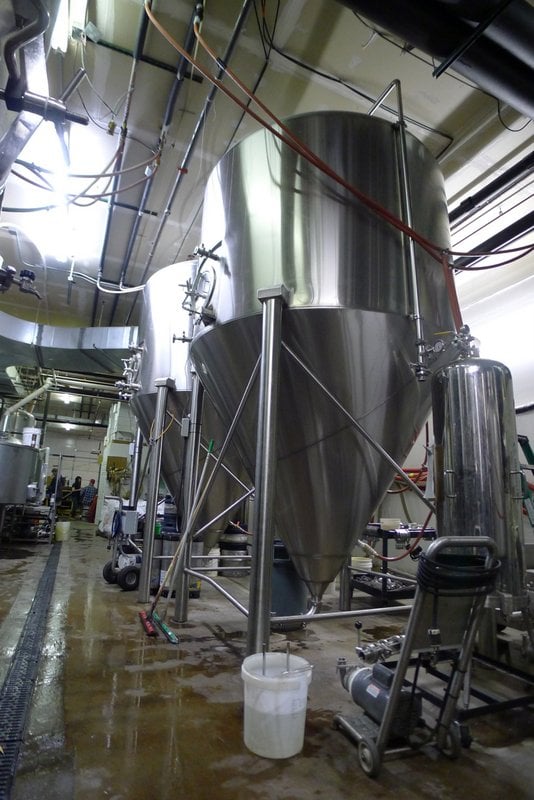

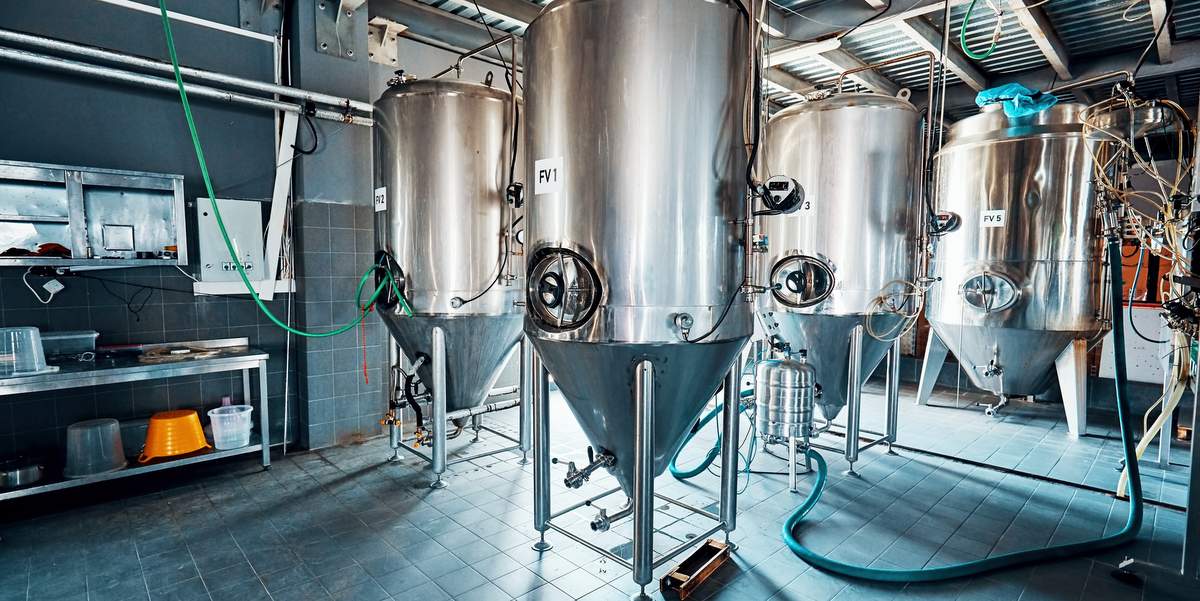

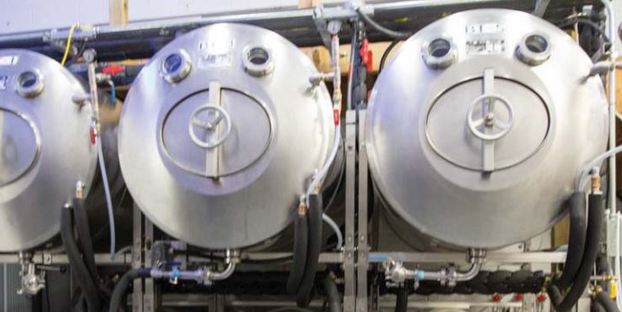
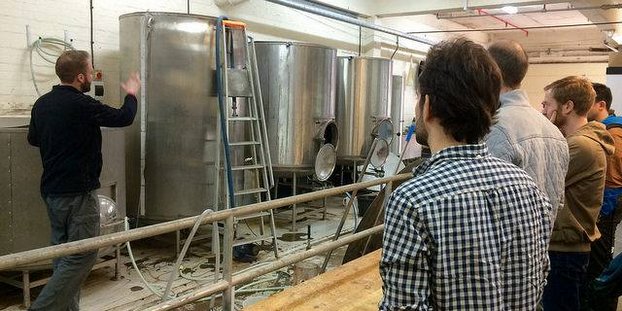
RT @CraftBrewingBiz: #Sundayreading Brewing Vessels: Cylindroconical #fermenters remain a craft beer staple… http://t.co/vqrnzMCzRG
RT @CraftBrewingBiz: Brewing Vessels Reviewed: Cylindroconical #fermenters remain a craft beer staple… http://t.co/scjTEwEY